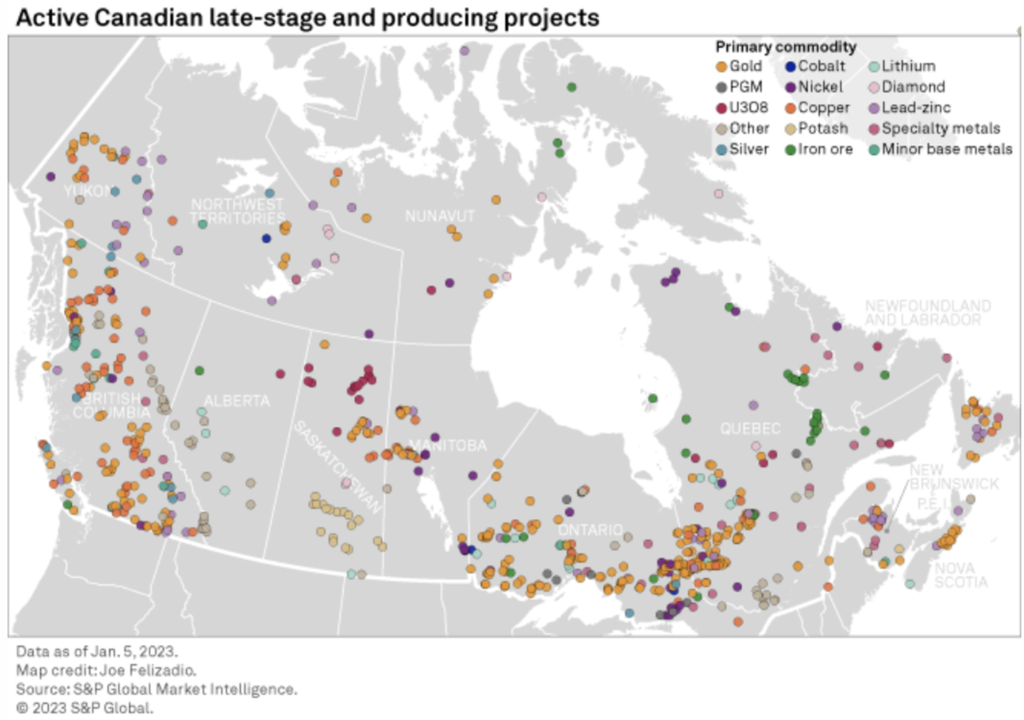Canada’s mining industry has never been short on investors or miners looking to take advantage of its mineral rich lands. In fact, Canada’s mining activity has experienced a significant increase since 2020, with S&P Global Commodity Insights reporting that 651 companies explored for nonferrous metals in Canada in 2022 — the most in a decade — up from 583 companies in 2021. The average budget per company also boosted 15% year-over-year to C$4.1M. This is an indication that the COVID-19 pandemic challenges the industry faced have waned, a reflection of Canada’s resilience and adaptability in the face of significant operational challenges.
Mining in Canada is certainly not a new industry, but recent developments have seen more and more companies setting up shop in both previously untapped, and popular, mining regions. Some of the notable areas experiencing heightened activity include Yukon, Quebec, Ontario, and British Columbia. Each of these areas has unique characteristics that attract different types of exploration.
Yukon Gold
In the Yukon, for instance, gold mining dominates the industry with substantial investments from companies such as Victoria Gold Corp (TSX: VGCX) and Minto Metals (TSXV: MNTO). These companies have invested heavily in the region, with their projects bearing profitable fruits.
Victoria Gold Corp’s Eagle Gold mine is one of the largest gold mines in Yukon history. Since the start of production, the Eagle Gold Mine has produced 2.048Moz of gold, generating an after-tax net present value at a 5% discount of US$954M (US$1,257M pre-tax), at US$1,700/oz of gold.
Minto Metals’ copper-gold mine is in the Minto Copper Belt and has been in operation since 2007, with underground mining commencing in 2014. Since 2007, approximately 500Mlbs of copper have been produced from the mine. The current mine operations are based on underground mining and a process plant to produce high-grade copper, gold, and silver concentrates.
Lithium in Quebec
Similarly, Quebec has seen an influx of lithium mining activity in the wake of the country’s efforts to ramp up electrification, with mines scattered across the province. The government has recently given the go-ahead for Galaxy Lithium’s (ASX: GXY) proposal of developing a lithium mine located 130km east of James Bay, adjacent to the Bill Diamond highway.
The 2021 James Bay preliminary economic assessment details a 330Ktpa spodumene operation, utilizing conventional open pit mining methods, a process flowsheet, and plant design like the company’s Mt Cattlin project. The Mt Cattlin project is a mature operation with stable production of a high-quality lithium spodumene, located in Australia.
Another well-established powerhouse in Quebec’s lithium mining scene is Sayona Mining Limited (ASX: SYA). Sayona is an emerging leader in the supply of lithium for North America’s efforts in electrification. The company owns various projects across the continent, with one of the most significant being its flagship North American Lithium (NAL) operation, situated in the La Corne township in Quebec’s Abitibi-Témiscamingue region.

Sayona has stated that the restart of NAL operations will signal the commencing of revenue generation, another step on its journey to becoming a prominent Canadian lithium producer. It will also support the Quebec government’s plans for a clean energy future based on the advancement of its own battery industry, from mining to downstream processing and electric vehicle production.
Copper and coal in British Columbia
British Columbia has long been known for its coal production, particularly metallurgical coal – an essential component in the production of steel. According to a report from the Ministry of Energy, Mines, and Low Carbon Innovation, as in previous years, coal was the highest value mine product (67.0%) in BC in 2022, followed by copper (17.8%).
The report explains that 11 mines were in production in 2022. Newcrest Mining Limited’s (ASX: NCM) Brucejack and Red Chris mines (Red Chris: 70% Newcrest, 30% Imperial Metals Ltd.) were the producing metal mines in the Northwest Region.
In the south-central region, operational mines include the two sizable copper-molybdenum producers, Taseko Mines’ (TSX: TKO) Gibraltar mine and Teck Resources’ (NYSE: TECK) Highland Valley Copper mine. Imperial Metals Corporation (TSX: III) also resumed activities at its Mount Polley mine in 2022.
The region also hosts two small precious metal mines, Bonanza Ledge II and Elk. Barkerville Gold Mines’ Ltd. (now under Osisko Development Corp. (TSXV: ODV)) The Bonanza Ledge mine restarted in 2017 as an underground long-hole and cemented fill operation below the existing pit.
Ontario nickel
Over the past couple of years, Ontario has attracted the attention of foreign majors and mid-tiers looking to expand into North America. According to GlobalData, Canada is the world’s sixth-largest producer of nickel, with output of 146Kt in 2022, up by 2% on 2021.
Melbourne-based BHP (NYSE: BHP), one of the world’s largest mining companies, moved its nickel and copper headquarters to Toronto in 2021.
Similarly, Ontario is home to mining giant Vale’s (NYSE: VALE) global base metal headquarters, its technology development centre in Mississauga, and its Port Colborne and Sudbury operations.
With five mines, a mill, and a smelter in Sudbury as well as a refinery in Port Colborne, Vale’s Ontario operations are among the world’s largest integrated mining complexes. The company produces low carbon nickel and copper as well as cobalt, platinum group metals, gold, and silver.
The company’s base metals operations not only helps Canada achieve the rank of 6th largest nickel-producing country, but also the 11th largest copper-producing country in the world as well. Its Copper Cliff Nickel Refinery in Sudbury also produces some of the purist nickel products in the world.
Further, Ontario was recognized as the first major jurisdiction to enforce a coal phase-out strategy in response to the Canadian government manoeuvring to eliminate non-metallurgical coal production by 2023, following a G7 agreement in May 2021.
Overall, Canada’s provinces all uniquely offer a wide range of mineral rich deposits. With the effects of COVID now dwindling, as well as the growing demand for green energy metals, Canada will remain in one of the top spots for mining activity throughout 2023 and 2024.












